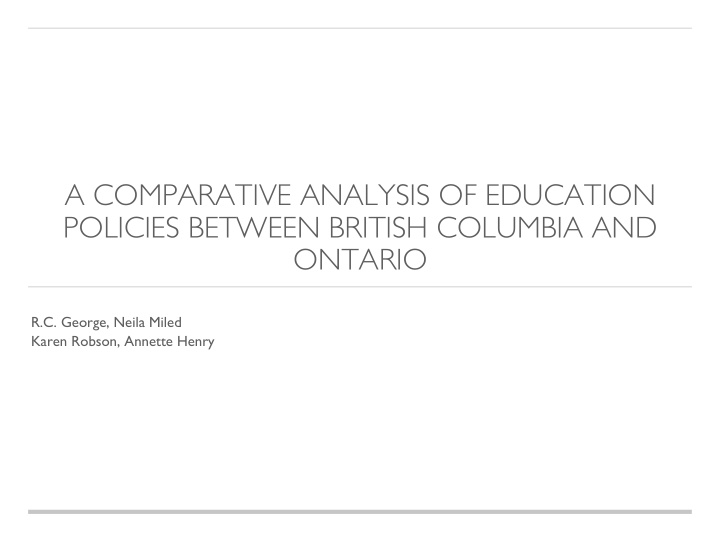



A COMPARATIVE ANALYSIS OF EDUCATION POLICIES BETWEEN BRITISH COLUMBIA AND ONTARIO R.C. George, Neila Miled Karen Robson, Annette Henry
INTRODUCTION From a 4-year SSHRC funded Gateway Cities Project Post-secondary education (PSE) crucial to socioeconomic mobility determining factor in enhancing the sense of “self-worth and belonging” among youth (Hausmann et al., 2007; Nora et al., 1996) Analyzes MOE policies in British Columbia and Ontario how do these policies facilitate /deny access to PSE for marginalized youth? Education is a provincial government responsibility in Canada (comparative lens is needed)
WORKING DEFINITIONS Marginalization involves social exclusion. Individuals or groups are denied economic, political, and/or symbolic power and pushed towards the ‘margins’ becoming ‘outsiders’ (Edgerton, 2010; Chandler and Munday, 2011) We focus on the ways that particular racialized minority and immigrant youth are differentially positioned or absent in policy
KEY WORDS Post-secondary education /PSE Access Equity Language Barriers Race / Ethnicity Special education Socio-economic status Intersectionality
METHODOLOGY Content analysis NVivo software to analyze BC and Ontario policy documents Critical policy sociology (Ball, 2003; Gillborn, 2015; Giroux, 2013; Henry, 2011). Policies are treated both as social structures and discourses, constructed to address particular issues We examine the texts and their contexts to understand the hidden assumptions behind policy discourses “policies come to be framed in certain ways—reflecting how economic, social, political and cultural contexts shape both the content and language of policy documents” (Taylor, 2006, p. 28) analysis will unveil not only the thick layers of policymaking but also the policy nuances (terminology, contexts and discourses) between Ontario and BC
POLICY CONTEXT (BC) “The Liberals came to power in 2001 with an initial agenda that marked the most radical shift in both substance and philosophical orientation in 40 years”(Fisher & Rubenson, 2013) End the 6-year tuition fee freeze Total deregulation of PSE fees Strong business influence Focus on Internationalization
POLICY CONTEXT (BC) Curriculum Changes ( focus on technology- oriented subjects – career education ) https://curriculum.gov.bc.ca/ Change in graduation requirement ( the provincial exams , 2 instead of 5 ) see https://curriculum.gov.bc.ca/ K-12 Context dominant discourses of ‘performativity, accountability” significant budget cuts , school closures. public money funding private schools Policies are guidelines adopted and updated by the school boards. A government with clear commitments to the Neoliberal Agenda.
POLICY CONTEXT (ONTARIO) Last 20 years have seen Conservatives (95-03) under Harris and Eves and then Liberal (2003-present) under McGuinty and Wynne Common-sense Revolution: cut waste: Public sector/education spending, income taxes, hospitals and social programs removed resources for anti-racist pedagogy under previous NDP government refocusing on merit Eliminated grade 13, changed curriculum, standardized testing (EQAO and literacy test), amalgamation of boards
POLICY CONTEXT (ONTARIO) McGuinty’s Liberals took reparative approach to Ontario considered equity and inclusive education “reparative” 90k additional HS graduates, higher literacy rates and full-day kindergarten Reaching Higher to increase access to PSE for underrepresented groups (disability, first-generation and aboriginal)
CONTENT ANALYSIS – ACCESS, BARRIERS AND EQUITY IN BC & ON POLICY (1993-2014) 70 60 50 (BC) Access 40 (ON) Access (BC) Barriers 30 (ON) Barriers (BC) Equity 20 (ON) Equity 10 0
CONTENT ANALYSIS – LANGUAGE, RACE AND SPECIAL ED IN BC & ON POLICY (1993-2014) 90 80 70 60 (BC) Language 50 (ON) Language (BC) Race 40 (ON) Race (BC) Special Ed 30 (ON) Special Ed 20 10 0
BC FINDINGS Visible / Invisible: Policy texts adopts the most “neutral” terminology Students are constructed within the discourses of “sameness” Fragmentation / no intersectional lens Visible : Language (Home language a major identity marker – ELL/ESL major issues) Policies around Special Ed are mostly connected to disability and lack consistency. Less visible as these programs are targeted by major budget cuts Race- Class- SEN ( controversial issues , the policy of denial and the fallacy of equity Equity /Access . New meanings in liberal times.
WHAT IS MISSING? “Create an inclusive education system that recognizes and supports the needs of Aboriginal, French-language, English Language Learning (ELL), international, and rural students, as well as students with special needs”( BC Budget, 2016) http://www.bcbudget.gov.bc.ca/2016/sp/pdf/ministry/educ.pdf? page=#4
ONTARIO FINDINGS Language Language Heavy emphasis on language education Policy revolves around French Immersion and the support for FSL and to a lesser extent, ESL Special Education Focus on access to special education and support for students with special needs Mostly MID, Behavioural and Autism and not gifted Therefore, Equity is often framed around issues of language and special education Race and ethnicity mentioned also, but not in substantive ways (listed with others) and is not officially measured
COMMON FINDINGS Race is constructed differently in BC vs. Toronto � Special education is defined in different ways � difference/diversity/race is constructed as Aboriginal or English Language Learners (ELL) in BC When removed, race talk in policy dwindles. Ontario talks about race/ethnicity as we commonly understand it, but don’t really address it or have any substantive policy Context and ambiguous language Intersectionality is mentioned in small ways is Ontario, but not at all in BC policy adheres to neoliberal agenda = enhancing privatization, not historicized or contextualized, not specific and ambiguous = lip service, socioeconomic
CONCLUSION Current policy in BC and Ontario uses ambiguous language to address issues of socioeconomic and race/ethnicity inequalities Without explicit addressing of these forms of inequity, these issues go unaddressed and cannot be properly applied and measured Is Is ra race/ ce/et ethnicit icity y tru ruly ly recog recognized ized as s a ma marg rgin inalizin lizing attrib ribute? e?
RECOMMENDATIONS Further research that examines the implementation/evaluation of these policies How they address issues of race/ethnicity/ socioeconomic class? Collect race data (MYAA) Why isn’t race/ethnicity counted as an urgent measurable category in provincial policies?
THANK YOU http://gatewaycitiesproject.info.yorku.ca
Recommend
More recommend